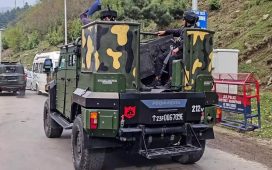
Mrs G was only expressing in a more serious manner what Hrundi V Bakshi, the hyper-Indian character played by Peter Sellers in the 1968 Blake Edwards-directed comedy The Party, said in a funny line: ‘In India, we don’t think who we are, we know who we are.’ A description, after all, is only a point of view. And PoVs with strategically placed cameras are central to good screenwriting, not to mention how movies portray inner thoughts through situations that express profound truths.
As articles, tweets, comments, outrageous trolling and at least in one case of news television, a reporter literally shouting inanities from the warzone keep pouring out in a torrential rate since last week’s horrendous attacks on Israel by Palestinian ‘enemies’, the nicer folks among us felt West Asia should taste better with hummus, not with the murderous marination of Hamas. In reflective moments – understandably rare these days – it becomes clear that truth© depends on which side of Jerusalem you are, a cliche that refuses to go away as a lasting metaphor that simultaneously connects and divides Judaism, Christianity and Islam.
But we live in the times of drone cameras that can transcend wailing walls and quarters segregated by religion and take shots from that heightened PoV called ‘above’. It would be wise to take an aerial look of the West Asia cauldron, which is what some filmmakers have tried to get to anything resembling truth.
Munich, Steven Spielberg’s 2005 movie on Palestinian terrorists killing Israeli athletes in the 1972 Olympic Games in the eponymous German city, shows this shapeshifting truth© beautifully. Spielberg shows how the person we call a terrorist can be a soft-spoken gentleman next door.
In a memorable scene, Palestinian and Israeli agents on the run suddenly come face-to-face in a Greek hideout. One group claims it is the separatist ETA (Euskadi Ta Askatasuna) from Basque Country, the region in northern Spain whose armed guerrillas the Spanish government used to call terrorists before the problem eased off. In that moment, Spielberg brings out the ordinary, vulnerable selves in the people who instil fear in their enemies, almost showing up sworn foes to be people who could be friends as well.Which brings us to the Balfour Declaration of 1917, which is in tangentially in the news again for history boffins, because it led to the British promise of a militarily enforced Jewish state that took shape three decades later. The Brits fought the Turks in World War 1 and created Saudi Arabia, and none better than Lawrence of Arabia, the Oscar-winning David Lean 1962 classic, tells us this story. It was apparently all part of London’s plans to make Ankara go Cold Turkey. If Peter Sellers showed the ‘Indian’ way through caricature, Peter O’Toole – playing Thomas Edward Lawrence, the military officer who brought Arab tribes together to fight Turkey – showed us the early 20th century British PoV on the West Asia conundrum.
A 1938 article by Mohandas Gandhi I revisited last week shows the Mahatma opposing the Jewish state, even as he spoke for the well-being of Jews, citing Arab sentiments. He seems to say that everybody is right in their way while being sensitive to all.
Which is quite like what is shown by Akira Kurosawa in his 1950 classic, Rashomon. As one review of the film puts it: ‘Four eyewitnesses recall a singular incident in the forest in wildly different ways, making the truth impossible to arrive at.’ The ongoing West Asian conflict, too, has four facets – history, geography, religion and politics. It would take us drone shots of the mind to get anywhere near the truth.










